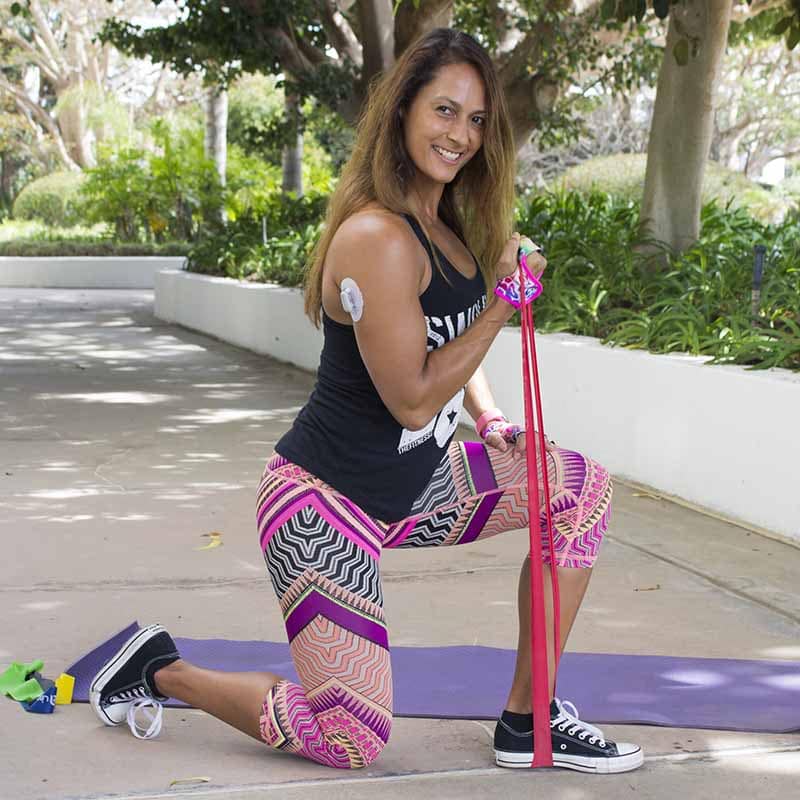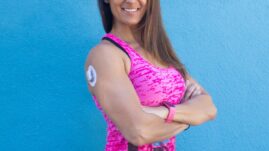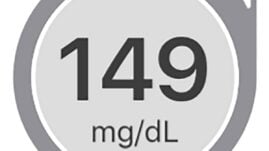This post may contain affiliate links. Please read our disclosure.
I love my CGM, but it has taken me a while to learn how to wear it all the time without irritation or itching, and without the adhesive tape falling off after a few days.
These CGM tips and tricks are based on my experience with the Dexcom G6, Dexcom G7, and FreeStyle Libre 2, but they should work for any CGM brand and model on the market.

How to find the right CGM placement for you
I’ve found that where I place the sensor has the largest impact on my overall comfort Where I place the CGM sensor has the largest impact on my overall comfort level, so it’s one of my most important CGM tips.
I prefer to place the Dexcom G6 and FreeStyle Libre 2 on my lower back or the back of my upper arms (the triceps), whereas I find the Dexcom G7 to work best for me on the stomach or upper thigh. This is where there’s the least chance of me bumping into something and tearing it off.
In this video, you can see some different places where you can wear the Dexcom G7.
On my lower back, I’ve found that I need to place it just above my belt/pants. If I place it below my belt, there’s a greater chance of me pulling it off whenever I wear jeans, and I find it uncomfortable to have my pants pushing on the sensor.
I also want to keep the sensor away from places where I bend. I attach it horizontally to minimize the chance of it getting in the way when I move around.
Placing the sensor optimally can be challenging and some sites I just can’t reach on my own, so Tobias will sometimes lend a helping hand.
And then there are some sites that just scare me, so I haven’t built up the nerve to try them yet (I’ve seen folks wear them on their calves!!).
How to make the CGM stay on
Making your CGM stay on for the duration of the sensor’s lifetime can be a problem, but there are tricks you can use to help keep your CGM on.
Use Skin Grip overlay tapes
Regular overlay tape, and especially the one Dexcom sends out, can make my skin irritated when the weather is really warm or I’m doing a lot of cardio.
This is my arm after just 3 days of using the Dexcom overlay tape. It’s almost like a burn and I could still see it after 3 months!

I find fabric patches like Skin Grip much more usable. They were originally designed with an active lifestyle in mind, and they really do the job! This is one of my top CGM tips for summer.
They keep the sensor in place for weeks without irritating my skin at all. Since the texture of the patch is more like a big bandage than plastic, it doesn’t feel like I’m wearing a patch and I forget about it pretty quickly.
Skin Grip comes in many different colors and designs, as well as a see-through tape that is barely visible.
If you, like me, are into colorful patches, their products are for you. You can use code DIABETESSTRONG for 10% off on the Skin Grib website.
Other overlay tape options
I prefer the Skin Grip overlay tapes, but there are many other options to choose from:
- Griff Grip has patches in a lot of crazy shapes and colors (how about a patch shaped like a T-Rex?) This makes them ideal for kids and people who like to accessorize their CGM.
- ExpressionMed also makes patches in a lot of different designs (including a Taylor Swift collection). Their patches are printed on material that feels more like paper than sports tape, which I am not a fan of, but they are still a solid option.
- Pump Peelz are similar to ExpressionMed in fabric, but their designs are a bit more “mature” than Griff Grip and ExpressionMed. I have used them and liked them, but they don’t last as long as Skin Grips.

Use Skin-Tac™ Adhesive Wipes to add extra adhesive to the sensor
If you find that your CGM falls off very quickly, Skin-Tac could be the solution for you.
It’s basically body glue that you apply to your skin and allow to dry before attaching the sensor. It makes the skin super sticky and acts as an extra adhesive.
I’ve never liked it too much since I’d get glue all over the place, but I know plenty from the diabetes community who love it.
Some also add Skin-Tac if the sensor starts coming off after a few days. Just add a little adhesive under the edge and reattach it that way.
Again, this method doesn’t work very well for me, maybe because it’s pretty hard to clean the area where the sensor has come loose.
It’s somewhat challenging to get off (from the area where you applied it and your hands), so I recommend using adhesive remover wipes to get the adhesive off.





Michele
Hello. For the last few days, according to my Free Style, (worn on my abdomen), I was in hypo a lot. Finally tested with a finger prick just after a Free Style reading of 45, and the finger prick reading was 320!!! I tested several times to be sure, with the same results. What gives? I’ve been wearing the Free Style on my abdomen for a couple of years with no problem. Why the false readings now?
Christel Oerum
It might have been a bad sensor, it happens. Good that you did a finger stick to verify. I’d call Abbott and let them know so that they can reimburse you for a defect sensor
Jeff Svoboda
I place it on my ample abdomen above the belt line. I use Skin Tac from a bottle with the cotton ball applicator. Simply wipe the ball around the sensor. Stays on until you peel it off. Checking readings manually with pin prick finds little variation.
Supriya
I found this article useful. One question however. Is is safe to do EMS TRAINING with the cgm patch? I have on my upper arm and the EMS Suit sleeves cover that area
Christel Oerum
I don’t have any experience with this. You might want to call the manufacturer of the CGM you use/consider and ask them that question. Most likely they’ll say that they don’t recommend it, but it’s worth a try
Kaitlyn
I have worked in EMS for a while and I always wear my cgm on the back of the arm. I have used both tapes mentioned above and they aren’t bothered by the uniform sleeves at all.
Rhonda
I use K-tape to keep my senor on. (Kinesiology Tape) . It’s made for movement and has been a game changer for me.
Jessica Windbigler
Does anyone have any suggestions how to keep your tape looking clean. Either the Dexcom tape starts to look dirty around the edges or the patch that goes over. I dont want to always cover up my patch because it looks dirty, especially at work or nice events.
Crystal Laplante
Hi
I’m new to your site and to Medtronic guardian CGM. It doesn’t seem to stay on when I insert in my abdomen. Could this be because I have fat there (as opposed to my upper arm). Also, this is a general question but do you have any advice for a type one who has gained a lot of weight as result of having surgery and being relegated to hospital and nursing home for 8 months in my 20s. I was diagnosed late at 27. Any input would be appreciated. Should I focus on cardio and do strength a couple times a week? I’m grateful that my job is physical and I often get 5 miles of movement there. Thanks for reading!
Christel Oerum
I don’t think the amount of fat in the place you put your sensor will impact how well it sticks. It’s most likely more to do with your skin, how much you sweat and how much hair you have. I’d suggest adding an overlay tape (see the links in the post) and tape it down to make sure it doesn’t fall off.
As for weight loss, first I’d suggest you focus on what you eat (you can find a lot of information here on the site on that). You need to establish what a calorie deficit looks like for you. As for exercise, I’d recommend a combination with more focus on resistance training. Depending on how much time you have, do resistance training 3-5 time weekly and if you really want to add a little cardio
Claudene Beyeaux
Since I started using the Dexcom G6 I have inserted it where suggested, however my sugar levels seem to be over 200 but the Libra Freestyle I wore on the back of my arm and my readings were always not going over 200. I haven’t changed anything in my activity or meals. Could placement change the change in the numbers?
Christel Oerum
It shouldn’t. Did you check with finger sticks to see if it was off? The sensor won’t impact your blood sugars, but many other factors can. Even a small infection or stress can make blood sugars run higher. All you can do is adjust your medication or alter your activity level
Sara
Crystal, I have gained weight since my diagnosis, and I also find that sensors do not stay on in my more “fluffy” areas. I know it has been two years since ypur post but I found it wheen looking for answers to the same questions. The only place that I have found for me that works is the back of my shoulder on the side I dont sleep on. It works really well for me because of the lack of nerves there I dont have the irritation issues. good luck, I hope you have found a workable solution.
Matt
I’m a weekend warrior… lots of gardening … digging stuff… . building stuff… .and I like to swim a few times a week…… PLUS I sweat like a pig (i hope pigs actually do sweat a lot… and aren’t ashamed by this phrase).
Anyway… I’ve was originally using skintac with a tegaderm patch… worked okay… but when I would sweat heavily… you could see the beads of sweat building under the patch… and it could become loose after a single day of work. … boo. So I changed to skintac with GrifGrips. They worked much better… but after a few rounds of sweating… it would start to peel on the edges. It did allow the sweat to evaporate through at least…. but the adhesive would start to fail a bit.
After getting frustrated… I contacted all the “patch” companies I could find… asked for samples. FYI… they all sent me some. I tried each one out…. trying them out on hot sweaty days. And the one that worked better by far then the rest is called SimPatch. I can keep it on for weeks on end without issue. The adhesive is stronger… so removing them can be painful if you don’t use alcohol to soften the adhesive.
Also… for me… my chest/belly sweat a lot more then the backs of my arms. Plus the skin on the back of my arms doesn’t fold/roll quite as much as my belly (sans a 6 pack).
Christel Oerum
Thank you Matt – I didn’t know that brand but will try it out. GrifGrips are hard for me to get off, BUT it really comes down to skin type.
Thanks again
Dee
Just love my SimPatch for use with the Freestyle Libre. One patch normally lasts at least the first seven of the fourteen days, but sometimes longer. Stays on during showers, swimming, sweating, etc.
Maureen
I just clicked on the “tag cutter” link and Amazon says it is no longer available.
tamer
hi, thanks for sharing your tips.
which tips suitable for swimming? to protext sensor during alot of swimming activities?
Thanks
Christel Oerum
You can go swimming with both but will have to leave the receiver behind. The transmitter will still collect information so you won’t miss any data (I’m not sure for exactly how long). I would recommend using some sort of overlay tape if you swim a lot. During the summer I’ve been really happy with the Grif Grips since they’ll allow my skin to breath and no way the sensor comes off
Kim Davis
I use grid grips & I use the flower shape. It is harder to apply but offers more flexibility than a square patch. It’s weird, sometimes I get a horrible reaction such as redness, itching, & sometimes it actually causes a sore( which I clean & monitor very closely). But I use a Dexcom G5 & as recommended I only use my abdominal area. It takes good forethought to plan where I insert the G5. In the beginning I also use Skin -Tax. My sensor stays on for 7 days!